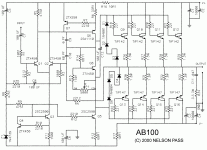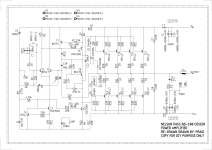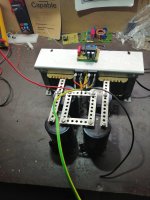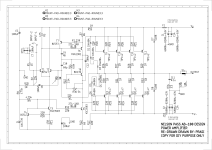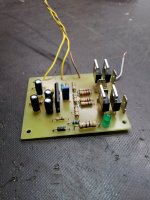Not sure which board design you are working with - but here are the original NP and I think the latest Prasi board schematic. Also is a BOM, not exactly spec'd to either board, but easy enough to change the small/medium transistors to those listed on either schematic. Note that the original NP schematic has R3 as 100r, which sets the gain at ~60, pretty high. I have tried 475r, 750r and 1k which set the gain at 46, 29 and 22. In the end I picked 750r, since that's the gain on most of my other amps and pairs well with my Preamp.
Attachments
Not sure which board design you are working with - but here are the original NP and I think the latest Prasi board schematic. Also is a BOM, not exactly spec'd to either board, but easy enough to change the small/medium transistors to those listed on either schematic. Note that the original NP schematic has R3 as 100r, which sets the gain at ~60, pretty high. I have tried 475r, 750r and 1k which set the gain at 46, 29 and 22. In the end I picked 750r, since that's the gain on most of my other amps and pairs well with my Preamp.
Any serious deviations from what Prazi posted in the PDF above? I am about to start building (finally) my AB100....
I don't see any huge issues - you will need (2) of the 1N5404 (your list only has 1 in quantity, but any 3-4A diode will work, I chose the cheapest and works fine.Any serious deviations from what Prazi posted in the PDF above? I am about to start building (finally) my AB100....
I preferred to go off the actual schematic, because those transistors I had on hand (MJE340 (Q5), MJE350 (Q6), KSC3503, KSA1381, BC547, BC557). I just printed out the schematic and went through and made the order on Mouser and crossed them off as I put them in my cart, or pulled from my stash.
Attachments
Not sure which board design you are working with - but here are the original NP and I think the latest Prasi board schematic. Also is a BOM, not exactly spec'd to either board, but easy enough to change the small/medium transistors to those listed on either schematic. Note that the original NP schematic has R3 as 100r, which sets the gain at ~60, pretty high. I have tried 475r, 750r and 1k which set the gain at 46, 29 and 22. In the end I picked 750r, since that's the gain on most of my other amps and pairs well with my Preamp.
Just double checking all my parts and noticed various opinions on what R3 should be.
I have 1K for R3 and 10R for R35 as per the Prasi schematic?
Will this be alright?
Last edited:
What difference would any of these make as the 1R emitter resistor?
The KOA Speer BPR58CF1R0J Current Sense Resistors - Through Hole 1 Ohm 5W 5% 350ppm and Vishay / Dale CPF31R0000DKB14 Metal Film Resistors - Through Hole 3watts 1ohms 0.5% have been suggested, but I don't have either.
I have the Ohmite Wirewound Resistors - Through Hole 5W 1 ohm 1% already.
Thank you,
David.
Last edited:
To avoid an additional order, I would try the Ohmmits you have on hand. NP also said earlier anything from 0.33 - 1r emitter resistors is fine - if you have a MOX resistor of those values on hand. I used metal oxide 0.47r 3 watt
I use the cheaper option linked all the time and haven’t had any issues.
I use the cheaper option linked all the time and haven’t had any issues.
@bullittstang
Does resistor composition (Wirewound vs. Metal Film vs. Metal Oxide vs. Current Sense Resistors) matter?
Or how close should they be matched, 1% vs. 5% vs. something else?
Does resistor composition (Wirewound vs. Metal Film vs. Metal Oxide vs. Current Sense Resistors) matter?
Or how close should they be matched, 1% vs. 5% vs. something else?
I think it depends on the stability of the amplifier design. Metal oxide tends to be pretty stable, with reasonable cost. Metal film is likely the more stable, however at a much higher price. Wire-wound is the cheapest, but again for most designs is perfectly fine, may have more heat drift of the value.
5% or less is fine, no matching needed.
5% or less is fine, no matching needed.
Started populating my boards and have come across a question.
The BOM calls out 220 for R35.
Board calls out 10 (optional) schematic also calls out 10.
Which is correct?
The consensus was R35 should be 10 ohm?
Thanks. Got it.post 1123hi
is there a gerber by prasi too?
chris
Hi Vrystaat.Just finished building the SSR, Bonzai's design, I have build a similar one before on my Slewmaster, works great. Prasi have made this design.
Where you found this pcb?
- Home
- Amplifiers
- Pass Labs
- AB100 Class AB Power Amplifier
